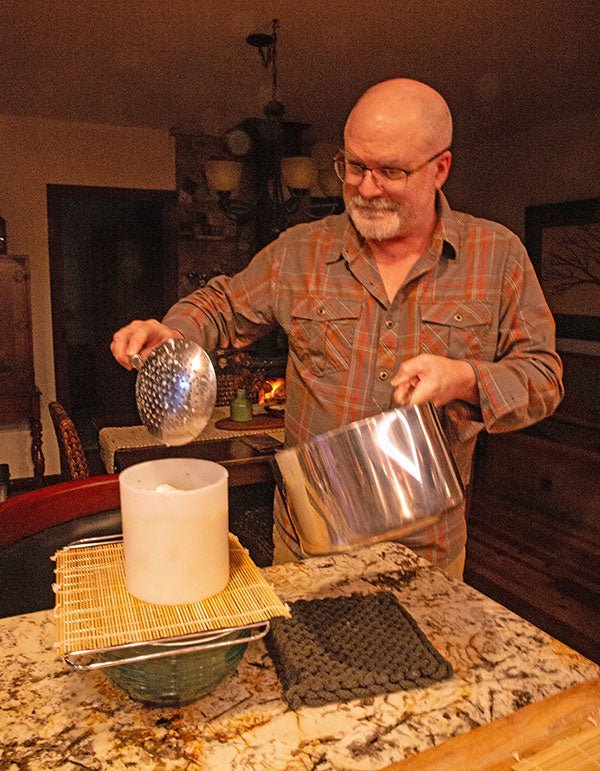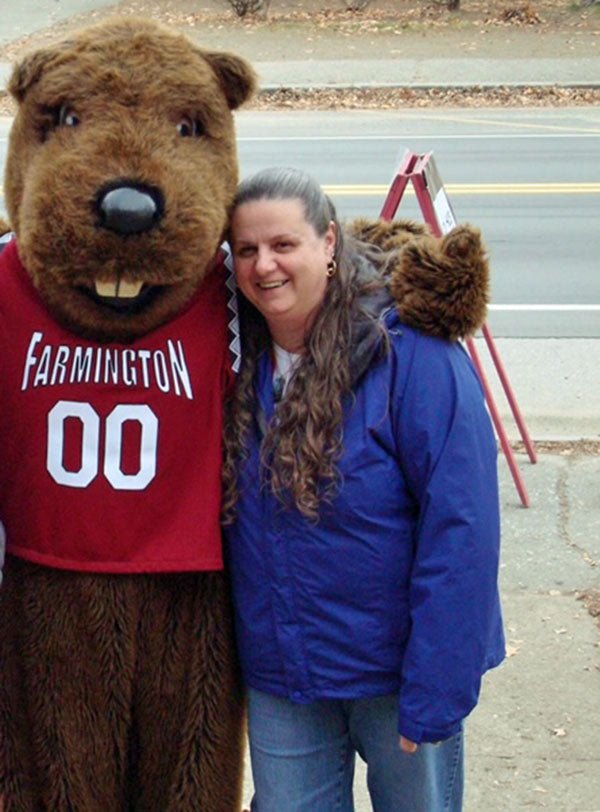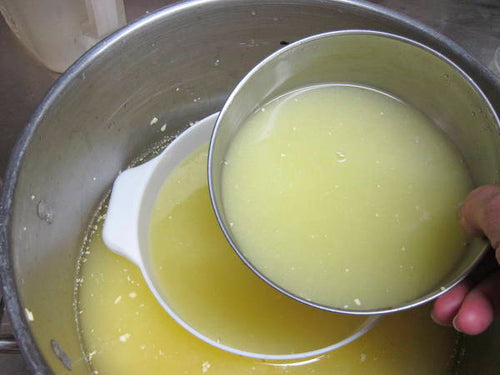
Fred on Dec 16th holding an Emmental that is done with warm aging and heading into the cave to mature. The large yellow wheel is the Formaggio Val’Campella which is ready for dry salting and also destined for the cave. In the very front, there is a red-spotted 1 gallon wheel of Guidos with dried Aleppo chili flakes (from his garden this year).
Well, here we are again with another fascinating cheesemaker. Fred has a million hobbies, he has traveled around the world, he has published a photography book and he makes fabulous cheese.
On top of all that, he has compiled an extensive amount of research about making cheese in the form of 2 spreadsheets:
- Cheese Recipe Index. Fred created this index because he found it difficult to find interesting recipes from all the books, videos and websites available. There are, at this point, 233 recipes on his list and he is adding more all the time. It, of course, includes recipes from our website (cheesemaking.com).
- Cheese Make pH Markers. This is another sorting and indexing project where he has listed the sets of pH markers for almost 100 cheeses. One of his sources is the Cheese Science Toolkit which has the pH ranges for hundreds of cheeses. (He would welcome any input/comments/additions.)
Fred’s Story
I’m a reliability engineering and management consultant and founder of the reliability engineering professional development site, Accendo Reliability (accendoreliability.com).
My work has taken me around the world and I have enjoyed working with teams on a wide range of products, factories, and systems to support product and system reliability. I teach, coach, consult and write about reliability engineering.
On a personal side, besides maintaining and improving our home, my many hobbies and interests keep me in a learning mode:
Traveling …
Biking …
Hiking …

Start of a hike from Tuolumne Meadows to Merced Lake along the John Muir Trail, Yosemite National Park
Mountain and rock climbing …
Photography …
A book with a collection of flower images.

Available at MagCloud
Gardening …

This is a little over a month ago, December 2021 and the garlic is sprouting, brassicas doing well, plenty of lettuces and herbs to enjoy. The raised beds are made with redwood branches that we got when thinning nearby redwoods to improve the sunlight to the garden.

An early spring view of our garden – very few trips to the market for produce. Lots of tomatoes, potatoes, beans, peppers, greens, etc.

The redwoods surround the garden on three sides – fortunately, in the summer we get about 9 hours of direct sun, so the full range of crops do just fine.

Gardens always need some chickens – not in the garden, yet they make good company, eggs, and manure.

The entrance gate (one of three) to the garden. The garden’s name is The Meadow. Someday we’ll finish the arch over the gate.
Also canning, home brewing, and woodworking.
Living in a rural, high fire danger area, I spend time helping neighbors remove brush and ladder fuels from our community.

With neighbors and friends clearing brush to reduce wildfire danger, Chemeketa Park, Santa Cruz Mountains, near Los Gatos, California
Cheesemaking:

Setting up to make Formaggio Val’Campella
I got into cheese making much as I got into a lot of other hobbies or activities -“There is always a way.” During a visit to northern Italy, my wife and I enjoyed cheese plates, on occasion. Once back home, we tried to find the range of wonderful cheeses we had enjoyed on vacation, but we couldn’t. The pecorino and the Alpine cheeses made in Italy created very fond memories, and we just could not find these cheeses in the US.
So, 3 years ago, considering there is always a way, we decided to learn how to make cheese. We found an introduction to cheese making class offered by Love Apple Farms in nearby Santa Cruz, California. We learned to make feta, chèvre, and mozzarella. It was fun and the resulting cheese, encouraging.
Then to books, YouTube, various websites, and eventually finding the online classes offered by Kate Johnson at The Art of Cheese. The encouragement and advice from the Art of Cheese community of home cheesemakers and range of resources helped turn the idea to make the memorable cheese from our Italian vacation into a reality. While not quite there, we are steadily making progress.
As you would say at New England Cheesemaking Supply Co., “There is always a whey.” Besides, it’s a challenge that has proven fun to master.

Setting up and making sure I had all the ingredients for a half-gallon Crescenza cheese. The same day, I made a few pints of persimmon jam from a neighbor’s tree and some “apple pie filling” filled hand pies with apples from another neighbor’s tree.
I started making cheeses with yogurt, then fresh cheeses like feta, chèvre, ricotta, and mozzarella, even a cultured butter once.
Dove into making hard cheese with a farmhouse cheddar and it turned out great. The list of makes continues with Fontina, Alpine Tomme, Montasio, Parmesan, Asiago, Hispanico (cow milk Manchego), Tete de Moine, Tomme Mountain Style, Guido’s Italian Hard Cheese (a short aging, easy make recipe from The Art of Cheese), Camembert, Selles Sur Cher, Gruyere, Appenzeller, Asiago Pepato, Emmental, and Bondon.

Asiago Pepato – I ground the peppercorns in a mortar and pestle and cooked a bit in water before adding to the curds at pressing time. 2 gallons.

Asiago Pepato cut open

Guidos with dried tarragon (from the garden). Guidos is a simple version of a tomme.

An Alpine tomme to the right with an early attempt at a natural rind. Lower left – a Fontina with a cleaner and younger natural rind. Upper left – Montasio.

First try at a Tete de Moine – got a few shavings off, yet the cheese was a bit pliable and didn’t like to create shavings very well. Still, tasted wonderful, so we cut it up and it was quickly gone.
Yogurt, feta, chèvre, and Parmesan get made regularly as they are household staples.

My first try at Manchego, plus a good batch of chèvre with garden-fresh nasturtiums.
The list is not complete as I didn’t keep very good (none actually) records for the first year or so.
The non-homogenized, low-temperature pasteurized cow’s milk I use is from the Straus Family Creamery. The goat’s milk is from the Summerhill Goat Dairy. I did find and try buffalo milk once, very expensive stuff, from Morsey’s.
My wife once bought a quart of ultra-pasteurized goat’s milk, and the folks from our weekly cheese chat recommended Kate Johnson’s (The Art of Cheese) recipe for goat milk caramel (now also a household staple).

A custom size cheese grotto inside a wine fridge. It completely stabilizes the temperature and humidity to 55°F and 85%RH.
There are plenty of wonderful challenges when making cheese, like having too many options for cheeses to make. There seem to be plenty of options these days to learn the craft – from local and online classes, videos, articles, websites, and books. Finding time to make cheese is my biggest challenge.
The next biggest challenge is being consistent over time. Keeping notes does really help when trying to replicate a make that turned out great, or when troubleshooting those that didn’t.

My notes. This was the first time I dry salted and found that it took about an hour for the applied salt to melt into the cheese. So, I made a note to that effect. The other notes are details on additions, temperatures, changes in timing and weights, if any, plus pH readings. While not perfect or even legible in my handwriting, it’s an attempt to document what actually occurred during the make along with any observations or notes for the recipe. The form is from The Art of Cheese.
Challenges abound – such as mozzarella that just won’t stretch to curds that just won’t knit when pressing. The recipes provide a guide, yet are not able to account for your specific milk being used, room temperature, and the many other factors that may require a bit of adjustment to overcome.
Sometimes, just being patient works well. Other times, it is a tad more heat, or maybe a bit more weight. I think the primary challenge, which is why I like cheese making so much, is paying attention to details and learning the art of ‘reading’ your curds or cheese during the process.
It’s amazing what one can make with just milk and a few other ingredients. The process makes such a difference in the cheeses while using essentially the exact same ingredients. It’s fascinating.
To get started, all you really need is a recipe, some milk, and maybe a few other ingredients. Depending on how you like to learn, maybe a course, book, or video would help boost your confidence and successes. While there is a lot that one could learn about cheesemaking, the best way, I think, is to learn by making cheese, asking questions, learning along the way, and enjoying the results.
When first starting, I just followed the recipe and most of the time the process went well and the resulting cheese was good. Yet, with an intent to make better cheese, the ongoing challenge is to learn more about the art of cheesemaking so the results are great.
The other day at the grocery store, when checking out with a gallon of goat milk, the checker asked what I was going to do with the milk. She seemed surprised with the answer of ‘making cheese.’ “That’s so cool,” she said.
It is pretty cool, making cheese that is. For anyone considering making cheese, knowing exactly what is in the cheese you’re consuming, and wanting to enjoy both the process and the results – I say, just get started.

































































































































































